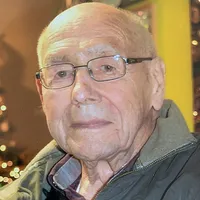As a young man, he enlisted in the Canadian Armed Forces in 1942. He was a member of the Royal Canadian Electrical and Mechanical Engineers, deployed overseas, landed in Scotland, and then was posted to the Elgin Regiment Armored Division as a fro ntline tank operator. He crossed the English Channel to fight in the Invasion of Normandy, took part in the breakout from Caen, the Closing of the Falaise Gap, and crossed the Rhine river driving a tank across a pontoon bridge to fight in the Battle of the Bulge. When the war ended, he was sent to Holland as a welding instructor before returning to Nova Scotia. He and Stella then moved to North Haven, Connecticut where he raised his family. He was a long-time employee of Yale University for over 30 years, where he worked as a senior technical specialist in nuclear physics. Jeune homme, il s'est enrôlé dans les Forces armées canadiennes en 1942. Il a été membre du Génie électrique et mécanique royal canadien, déployé outre-mer, a atterri en Écosse, puis a été affecté à la division blindée du régiment d'Elgin en tan t qu'opérateur de char de première ligne. . Il a traversé la Manche pour combattre dans l'invasion de la Normandie, a participé à l'évasion de Caen, à la fermeture de la brèche de Falaise et a traversé le Rhin en conduisant un char sur un pont flottant pour combattre dans la bataille des Ar dennes. À la fin de la guerre, il est envoyé en Hollande comme instructeur de soudage avant de retourner en Nouvelle-Écosse. Lui et Stella ont ensuite déménagé à North Haven, Connecticut, où il a élevé sa famille. Il a été un employé de longue date de l'Université de Yale pendant plus de 30 ans, où il a travaillé comme spécialiste technique senior en physique nucléaire. |



 I967624
I967624 



